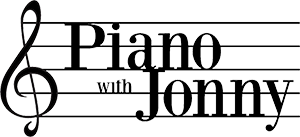Play Miles Davis’ “All Blues” on Piano
Learning Focus
Music Style
Free Lessons
Get free weekly lessons, practice tips, and downloadable resources to your inbox!
Miles’ Davis’ “All Blues,” from his iconic 1959 album Kind of Blue, presents an fresh and fashionable take on the traditional blues form. In today’s Quick Tip, Play Miles Davis’ “All Blues” on Piano, John Proulx helps piano students learn to play this sublime jazz-blues standard.
- Intro to “All Blues”
- Miles Davis’ “All Blues” Song Analysis
- “All Blues” Piano Chords
- “All Blues” Accompaniment Groove for Piano
Intro to All Blues
“All Blues” is a blues composition by Miles Davis written in 6/8 time with a medium jazz-waltz feel. The song is one of five compositions included on Miles Davis’ 1959 Kind of Blue, a studio album of massive musical and historical significance. For starters, Kind of Blue is widely recognized as the best-selling jazz record of all time, achieving 5x platinum certification in 2019 with sales in excess of 5 million units.¹ However, the album’s colossal commercial success is eclipsed by its even more significant achievement in pioneering a new direction in jazz history with its bold exploration into modal jazz composition.
Miles Davis
“All Blues” (1959)
One aspect of the extraordinary achievement of Kind of Blue was Davis’ complete commitment to capturing purely spontaneous musical expression. As such, the group never rehearsed the tunes prior to the recording sessions and the players were provided only minimal sketches of what was to be played.² Moreover, “almost all the tracks were the first complete takes—no edits, no second tries.”³
The musicians heard on the original “All Blues” recording from Kind of Blue include Miles Davis (trumpet), Julian “Cannonball” Adderley (alto sax), John Coltrane (tenor sax), Bill Evans (piano), Paul Chambers (bass) and Jimmy Cobb (drums). In addition, Wynton Kelly appears on Kind of Blue playing piano on “Freddie Freeloader” instead of Bill Evans.
In the next section, we’ll take a closer look at the some of the unique musical aspects of “All Blues.”
Miles Davis’ “All Blues” Song Analysis
One of the most remarkable aspects about Miles’ Davis “All Blues” is its feel. The groove and texture are simply mesmerizing. Of course, there are several musical components working together to create this one of a kind ethereal feel. In this section, we’ll examine:
- Key and Meter
- Paul Chambers’ Iconic Bass Line
- The “All Blues” Vamp
- Bill Evans’ Piano Tremolo Effect
The examples that appear in today’s lesson are excerpted from the lesson sheet PDF that corresponds to this lesson. In fact, if you’re already a PWJ member, you can download the sheet music and backing tracks for this lesson from the bottom of this page after logging in with your membership. In addition, PWJ members can also transpose the lesson materials to any key using our Smart Sheet Music.
Key and Meter
Miles Davis’ “All Blues” is a blues in G. In the liner notes, Bill Evans describes the tune as a 12-bar blues in 6/8 time. Nevertheless, the feel of the tune is that of a jazz-waltz.
Lead sheets for “All Blues” are readily available in both 6/8 and 3/4 time. The advantage to notating the tune in 6/8 is that the 12-bar blues form is clearly preserved. However, there are also challenges to publishing it 6/8. In particular, the use of a 6/8 meter requires prevalent use of dotted 8th notes and 16th notes, which are harder to read. Some music publishers have opted to divide each measure of 6/8 into two bars of 3/4 instead, which makes the tune easier to read. The latter approach reinforces the jazz-waltz feel and eliminates the need for 16th notes. However, the blues form in 3/4 time takes up a total of twenty-four bars as opposed to twelve, potentially cloaking an otherwise obvious song form.
For this lesson, we’ve selected the 3/4 time signature approach for a more accessible notation experience.
Paul Chambers Iconic Bass Line
Let’s begin by examining Paul Chambers iconic bass line on “All Blues.” You’ll notice that he plays a persistent bass ostinato for more than two-thirds of the form, which produces an almost hypnotic effect.

Next, let’s look at another background figure that recurs frequently in “All Blues.”
“All Blues” Vamp
In addition to Paul Chambers’ bass ostinato, “All Blues” contains a second recurring pattern that is best described as a “vamp,” which is simply a repeated accompaniment figure.
“If the rhythm section is swinging, the horn players don’t need to use as many notes. And the vamp on this song almost swings by itself.”
—Ted Gioia, Jazz Critic and Author
The vamp first appears when it is played by the saxes during the introduction. Afterward, the saxes continue the vamp underneath the melody on the head. Later, Evans picks up the vamp on piano behind the soloists and introduces some rhythmic variations. In terms of the overall song form, the vamp also functions as an interlude between each soloist.

Next, let’s consider another subtle effect which shapes our listening experience of Miles Davis’ “All Blues.”
“All Blues” Piano Tremolo Effect
From the very opening of “All Blues,” there is yet another hypnotic texture at work. Bill Evans adds a soft piano tremolo in the middle register of the piano that resembles the sound of a Leslie speaker on a Hammond organ. In the following video demonstration, the tremolo is played with the right hand while the left hand plays the bass line. However, in an ensemble setting, the tremolo can be played with two hands. Nevertheless, Jimmy Cobb (drums) once stated in an interview that Bill Evans played this tremolo with his left hand.⁴

Next, let’s turn our attention to the chords for “All Blues.”
“All Blues” Piano Chords
In this section, we’ll dig in the chords and voicings that you need to know to play Miles Davis’ “All Blues” on piano. In one sense, the chords for “All Blues” are quite simple. For instance, there are just four chords in all (G7, C7, D7#9, Eb7#9). However, the “All Blues” vamp that occurs so prevalently throughout the composition reflects a more advanced harmonic approach that is based on modal voicings. But first, let’s review the overall form of “All Blues” so we can grasp where each of the chord changes occur.
Modal Voicings in “All Blues”
The first and most frequently occurring chord in “All Blues” is G7. Notice that this chord lasts for long stretches of time throughout the form. As such, playing a single voicing over and over would result in a rather stagnant and monotonous accompaniment. Instead, Bill Evans uses modal voicings, which are chord shapes that move diatonically through a mode for the duration of a given chord. As such, modal voicings do not rely on guide tones (3rd and 7th) or chord extensions (9th and 13th) like more traditional voicings.
Some of the most common chord shapes used to play modal voicings are inverted triad shapes and stacks of fourths. In fact, the “All Blues” vamp—which is comprised of three second-inversion triads from G Mixolydian—is an prime example of the modal voicing approach. Of course, these are not the only triads available in G Mixolydian. The following example shows all of the second-inversion triad shapes that can be played with G Mixolydian as a parent scale. Note: the formula for a Mixolydian scale is 1–2–3–4–5–6–♭7. In other words, it is like a major scale with a lowered 7th tone. [Learn more about Mixolydian]
G Mixolydian 2nd Inversion Triads

When these second-inversion triads are played against a bass note of G, you’ll notice that some sound more consonant while others are more dissonant. Often times, effective use of modal shapes involves an intentional melodic line in the uppermost voice. For instance, the second-inversion triads in the “All Blues” vamp begins with the scale tones 5–6–♭7 of G Mixolydian, which forms a melodic cell with a singable quality. This melodic cell also works in a descending manner, as in ♭7–6–5. Hence, the complete vamp contains the melodic line 5–6–♭7–6–5.
The second phrase of “All Blues” follows typical harmonic movement for blues in that it moves to the Ⅳ⁷ chord, which is C7 in this case. Therefore, let’s play second-inversion triads using C Mixolydian as a parent scale.
C Mixolydian 2nd Inversion Triads

When we get to the third phrase of “All Blues,” the chords begin to change more rapidly, just like in a traditional blues. However, instead of a typical ⅱ⁷→Ⅴ⁷→Ⅰ⁷ or a Ⅴ⁷→Ⅳ⁷→Ⅰ⁷ turnaround, Miles gives us Ⅴ⁷→♭Ⅵ⁷→Ⅴ⁷→Ⅰ⁷. Here, Miles and the band lean into the dominant 7(♯9) sound. The following example shows how to play D7(♯9) and E♭7(♯9) voicings in the third phrase of “All Blues.”
Altered Dominant Voicings

Once you feel comfortable playing these voicings, you’re ready to move on to the final section of today’s lesson.
“All Blues” Accompaniment Groove for Piano
In this section of today’s lesson, we’ll combine Paul Chambers’ iconic bass line with the “All Blues” vamp to create an unmistakable “All Blues” piano groove that you can use to accompany a soloist or to frame your own solo piano arrangement. (In the following example, the modal second-inversion triad shapes are labeled for your convenience.)

Conclusion
Congratulations, you’ve completed today’s Quick Tip on Play Miles Davis’ “All Blues” on Piano. Without a doubt, the skills that you’ve acquired in this lesson will make a notable impression on anyone who hears your playing.
If you enjoyed this lesson, be sure to check out the following PWJ resources:
Courses
- Jazz Waltz Challenge (Beg–Adv)
- Jazz Waltz Rhythm Essentials (Beg/Int, Adv)
- How to Improvise a Solo with the Mixolydian Mode (Int, Adv)
- Altered Dominant Rootless Voicings (Int)
- 5 Jazz Comping Approaches (Int, Adv)
- G Blues Improvisation (Int, Adv)
- The Bible of Blues Riffs (Int, Adv)
- Scales for Improv on 7th Chords (Int/Adv)
Quick Tips
- How to Play Piano Like Bill Evans (Int/Adv)
- Piano Musical Modes–The Complete Guide (Int)
- The 10 Most Important Jazz Scales (Int)
- Modern Jazz Piano Soloing–Quartal Shapes (Int)
- Rootless Voicings for Piano: The Complete Guide (Int)
- Rhythm Changes–A Complete Guide (Int)
- Jazz Piano 1 Year Practice Plan (Beg–Adv)
- Beginner Blues Piano 1-Year Practice Plan (Beg)
Jazz Swing Learning Tracks
Blues Piano Learning Tracks
Thanks for learning with us today! We’ll see you next time.
Would you like to comment on this lesson?
Visit this Quick Tip on YouTube
¹ “Gold & Platinum.” RIAA, Recording Industry Association of America.
² Evans, Bill. Liner notes. Kind of Blue. Columbia Records, 1959. LP.
³ “Kind of Blue.” Miles Davis, Sony Music Entertainment, 2025.
⁴ Myers, Marc. “Jimmy Cobb (1929-2020).” JazzWax.com, 26 May 2020.
 Writer
Writer
Michael LaDisa
Michael LaDisa graduated from the University of North Texas with a major in Music Theory & Composition. He lives in Chicago where he operates a private teaching studio and performs regularly as a solo pianist. His educational work with students has been featured on WGN-TV Evening News, Fox 32 Good Day,...
More Free Lessons
Learn a super fun, jazzy version of this classic Christmas tune with crunchy chords and sweet fills.
Whenever I need to "fill in the gaps," this is my go-to technique!
If there's one thing that will stop you from progressing at piano, this is it.
Looking for downloads?
Subscribe to a membership plan for full access to this Quick Tip's sheet music and backing tracks!
Join Us
Get instant access to this Quick Tip and other member features with a PWJ membership!
Guided Learning Tracks
View guided learning tracks for all music styles and skill levels
Progress Tracking
Complete lessons and courses as you track your learning progress
Downloadable Resources
Download Sheet Music and Backing Tracks
Community Forums
Engage with other PWJ members in our member-only community forums
Become a better piano player today. Try us out completely free for 14 days!




